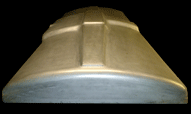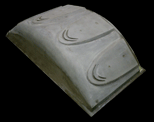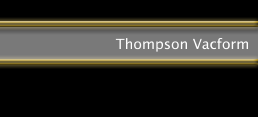The careful design of vacuum formed plastic components can produce attractive and functional products at a very competitive cost. Consideration should be given to the tooling costs, moulding costs (including the cost of the plastic and the amount of waste) and the trimming costs.
|
Tooling costs
Vacuum forming moulds can be made from various materials;
|
 Aluminium is the most expensive and is used when production volumes are high. It is the most durable and hard wearing material in use. In our experience they do not seem to wear out at all. Aluminium dissipates heat very quickly allowing for shorter cycle times. Aluminium is the most expensive and is used when production volumes are high. It is the most durable and hard wearing material in use. In our experience they do not seem to wear out at all. Aluminium dissipates heat very quickly allowing for shorter cycle times.
|
 Resin is the most popular choice. This is usually supplied as either a two pack liquid epoxy or liquid polyurethane system. Once mixed they set to form a solid mould. We can carry out this process in house which shortens lead times. Resins can produce far better detail than can be obtained with sand cast aluminium. They can also be more easily altered and repaired. Resin is the most popular choice. This is usually supplied as either a two pack liquid epoxy or liquid polyurethane system. Once mixed they set to form a solid mould. We can carry out this process in house which shortens lead times. Resins can produce far better detail than can be obtained with sand cast aluminium. They can also be more easily altered and repaired.
|
 MDF is cost effective for prototypes and limited production runs, although these moulding tools can very quickly overheat and deteriorate in use. They need an excessive amount of time to cool between mouldings and are therefore not practical for full production. MDF is cost effective for prototypes and limited production runs, although these moulding tools can very quickly overheat and deteriorate in use. They need an excessive amount of time to cool between mouldings and are therefore not practical for full production.
|
Moulding Costs
Moulding costs are proportional to the thickness of the material being moulded and to the design of the mould it’s self.
Thicker plastic not only costs more, but has a longer moulding cycle. There is an optimum thickness at which the criteria for the physical properties of the component have been reached.
Aluminium moulds produce the shortest production cycle and therefor incur the lowest moulding costs. Resin has slightly longer cycles, while MDF has the longest.
|

Multi-impression tools can reduce unit costs |
Trimming
We have full facilities for trimming the vacuum formed components.
Trimming in a single plane, using a band saws, spindle moulder or router is the most cost effective and common method. Storage trays, machine panels, bath panels and thousands of other products are made in this way.
If more complicated trims cuts are necessary this is not a problem, but the simpler the cut the less expensive it will be. |










